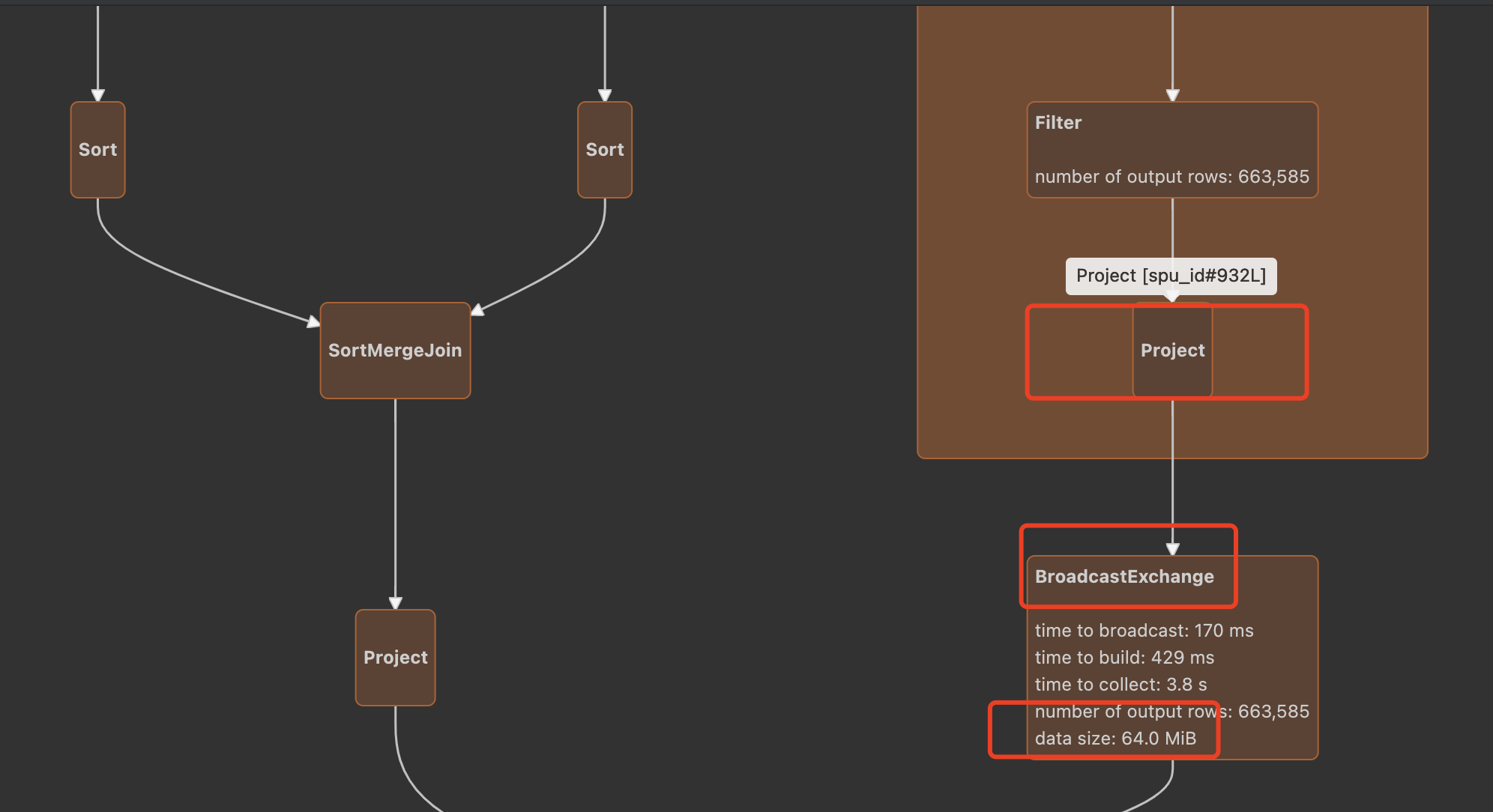背景
本文基于spark 3.2
driver内存 2G
问题描述
在基于复杂的sql运行中,或者说是存在多个join操作的sql中,如果说driver内存不是很大的情况下,我们经常会遇到如下报错:
Caused by: org.apache.spark.SparkException: Could not execute broadcast in 800 secs. You can increase the timeout for broadcasts via spark.sql.broadcastTimeout or disable broadcast join by setting spark.sql.autoBroadcastJoinThreshold to -1
at org.apache.spark.sql.execution.adaptive.BroadcastQueryStageExec$$anon$1.run(QueryStageExec.scala:217)
at java.util.concurrent.Executors$RunnableAdapter.call(Executors.java:511)
at java.util.concurrent.FutureTask.run(FutureTask.java:266)
at java.util.concurrent.ScheduledThreadPoolExecutor$ScheduledFutureTask.access$201(ScheduledThreadPoolExecutor.java:180)
at java.util.concurrent.ScheduledThreadPoolExecutor$ScheduledFutureTask.run(ScheduledThreadPoolExecutor.java:293)
at java.util.concurrent.ThreadPoolExecutor.runWorker(ThreadPoolExecutor.java:1149)
at java.util.concurrent.ThreadPoolExecutor$Worker.run(ThreadPoolExecutor.java:624)
at java.lang.Thread.run(Thread.java:748)
其实从字面上就可以理解:broadcast的数据超时了,这种经常是由于广播的数据量太大引起的(还有部分是由于SPARK-33933所说的问题引起的),spark中默认的广播大小不是只有10M才会进行广播么?
spark.sql.autoBroadcastJoinThreshold默认为10M
为什么还会存在广播的数据量很大呢?
问题分析
直接说重点:
在spark中 SMJ转BHJ 在两个阶段会发生:
- 正常的物理计划的生成阶段,也就是SparkPlanner中的JoinSelection规则中
- AQE阶段,也就是AdaptiveSparkPlanExec中的reOptimize方法
其实这两个阶段调用的方法都是一样的都是调用了sparkPlanner的JoinSelection规则
我们说说第一阶段,也就是正常的物理计划的生成阶段,即JoinSelection规则
这里的重要的方法是canBroadcastBySize:
def canBroadcastBySize(plan: LogicalPlan, conf: SQLConf): Boolean = {
plan.stats.sizeInBytes >= 0 && plan.stats.sizeInBytes <= conf.autoBroadcastJoinThreshold
}
具体的逻辑阶段的统计信息,可以参考spark logicalPlan Statistics (逻辑计划阶段的统计信息),这里如果我们是基于文件读取的话(大部分就是基于文件的读取),如果说我们的的sql是
##其中tableA有很多字段,我们只选取a,b两个字段
select a,b from tableA
这里的逻辑阶段的数据统计就是一个大概的计算:
private def visitUnaryNode(p: UnaryNode): Statistics = {
// There should be some overhead in Row object, the size should not be zero when there is
// no columns, this help to prevent divide-by-zero error.
val childRowSize = EstimationUtils.getSizePerRow(p.child.output)
val outputRowSize = EstimationUtils.getSizePerRow(p.output)
// Assume there will be the same number of rows as child has.
var sizeInBytes = (p.child.stats.sizeInBytes * outputRowSize) / childRowSize
if (sizeInBytes == 0) {
// sizeInBytes can't be zero, or sizeInBytes of BinaryNode will also be zero
// (product of children).
sizeInBytes = 1
}
// Don't propagate rowCount and attributeStats, since they are not estimated here.
Statistics(sizeInBytes = sizeInBytes)
}
...
def getSizePerRow(
attributes: Seq[Attribute],
attrStats: AttributeMap[ColumnStat] = AttributeMap(Nil)): BigInt = {
// We assign a generic overhead for a Row object, the actual overhead is different for different
// Row format.
8 + attributes.map { attr =>
if (attrStats.get(attr).map(_.avgLen.isDefined).getOrElse(false)) {
attr.dataType match {
case StringType =>
// UTF8String: base + offset + numBytes
attrStats(attr).avgLen.get + 8 + 4
case _ =>
attrStats(attr).avgLen.get
}
} else {
attr.dataType.defaultSize
}
}.sum
}
我们看到其实就是对于从一个表中读取一个字段的大小是基于改字段类型所占avgLen的大小除以该表中所有字段总的类型的avgLen的一个比值,或者是默认值:
如: select a from tableA, 假如tableA是300M 有a,b,c,d,e等30个字段,其中a,b,c,d,e等30字段都是string类型,且defaultSize是20。
则该sql算出来的size就是 20/(30*20)*300M=10M 这样这个sql所对应的临时表就能进行广播。
但是正如spark里说的:
Statistics collected for a column.
1. The JVM data type stored in min/max is the internal data type for the corresponding Catalyst data type. For example, the internal type of DateType is Int, and that the internal type of TimestampType is Long. 2. There is no guarantee that the statistics collected are accurate. Approximation algorithms (sketches) might have been used, and the data collected can also be stale.
Params:
distinctCount – number of distinct values
min – minimum value
max – maximum value
nullCount – number of nulls
avgLen – average length of the values. For fixed-length types, this should be a constant.
maxLen – maximum length of the values. For fixed-length types, this should be a constant.
histogram – histogram of the values
version – version of statistics saved to or retrieved from the catalog
这些统计信息有可能是不准确的(实际上String是变长类型),所以在计算的时候,有可能broadcast的数据就相对比较大,如果存在这种join有很多的情况下,就会导致driver端很卡,甚至OOM
我们再说说第二阶段,也就是AQE阶段
其实这个阶段核心还是getFinalPhysicalPlan方法中的createQueryStages方法和reOptimize方法,
在createQueryStages方法中如果方法已经是BroadcastExchangeExec的话,就会直接包装成ShuffleQueryStageExec,
如果是ShuffleExchangeExec的话,在下一个阶段会经过reOptimize方法根据运行时的统计信息大小,来进行是否可以进行SMJ到BHJ的转换
这里在的阈值判断是通过spark.sql.adaptive.autoBroadcastJoinThreshold来判断的,默认也是10M,
所以在spark UI上有时候能看到broadcast 的datasize有50M甚至100多M,而明明broadcast的阈值是10M,却变成了BroadCastHashJoin。
如下如所示:
结论
所以在大数据量,以及在复杂的sql情况下,禁止broadcasthashjoin是明确的选择,毕竟稳是一切运行的条件,但是也是可以根据单个任务个别开启。
今天的文章在spark的软件中_spark干啥用的「建议收藏」分享到此就结束了,感谢您的阅读。
版权声明:本文内容由互联网用户自发贡献,该文观点仅代表作者本人。本站仅提供信息存储空间服务,不拥有所有权,不承担相关法律责任。如发现本站有涉嫌侵权/违法违规的内容, 请发送邮件至 举报,一经查实,本站将立刻删除。
如需转载请保留出处:https://bianchenghao.cn/88165.html

